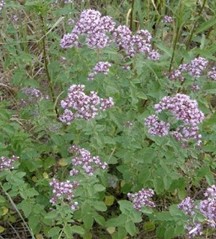Area
Tograyhon grows on small rocky slopes in the lower and middle parts of all mountain zones of Uzbekistan.
Botanical description of the plant
Perennial, fragrant herbaceous plant, 30-60, sometimes up to 90 cm in height. The stems are several, erect, the upper part is branched, hairy and four-sided. The leaves are simple, elongated, ovate, with a sharp tip, flat-edged, opposite the stem with a band. The flowers are small, located in the axils of leaves 2–3, forming a thyroid inflorescence does. Thyroid inflorescences at the tip of the stem forms an inflorescence. Fruit - with calyx combined four nuts. It blooms from June to September.

Medicinal properties
The plant calms the central nervous system, enhances digestion and secretion of bronchial glands. Decoction is known as a strong diuretic. Tugrayhon is also used as an appetite suppressant and expectorant in various colds. Swelling in sore throats and bathing in skin purulent diseases. The essential oils it contains are a painkiller in dental diseases.
Growing technology
In spring, the field is plowed and leveled. Usually in March-April, seeds are sown at the rate of 5 kg per hectare in the vegetable planting equipment. To make the seeds fall evenly, 1/5 amount of sand or other filler is mixed with it and planted at a depth of 0.5 cm. After that, the planted soil should be slightly compacted using a roller. When the grass grows, but without precipitation, when the surface of the soil is dry, as well as during planting, the sowing equipment is also attached to the seedbed. Irrigated by succulent watering, otherwise the crop may be completely washed away. In particular, the seeds can germinate evenly if the topsoil is kept moist for 2-3 weeks. Grasses begin to appear 10-16 days after sowing. At first, the growth is slow and it is overgrown with weeds. Therefore, after both waterings, the soil is loosened and weeded, and if the crop is dense, it is uniform. In the first year it is watered up to 12 times during the season, in subsequent years up to 8-9 times (April-1, May-2 (1), June-July 2, August-2 (1), September-1). In mid-July, 50 kg of nitrogen fertilizer per hectare is applied before sowing. The upper part of the stem (80 cm long stem) is harvested during the general flowering period (late June - early July). To do this, a gardener uses a scythe, and in large areas, a silage harvester or hay harvester. In this case, the cutting parts and tools must be sharp, sharp tools, because impenetrable tools damage the crop, the plant can even be uprooted.
7 cm in the harvested shed. spread out to a thickness of up to When well dried, it is passed through a 2–2.5 cm grid sieve, separated from the stems of flowers and leaves. Yields are 8-10 quintals per hectare.





